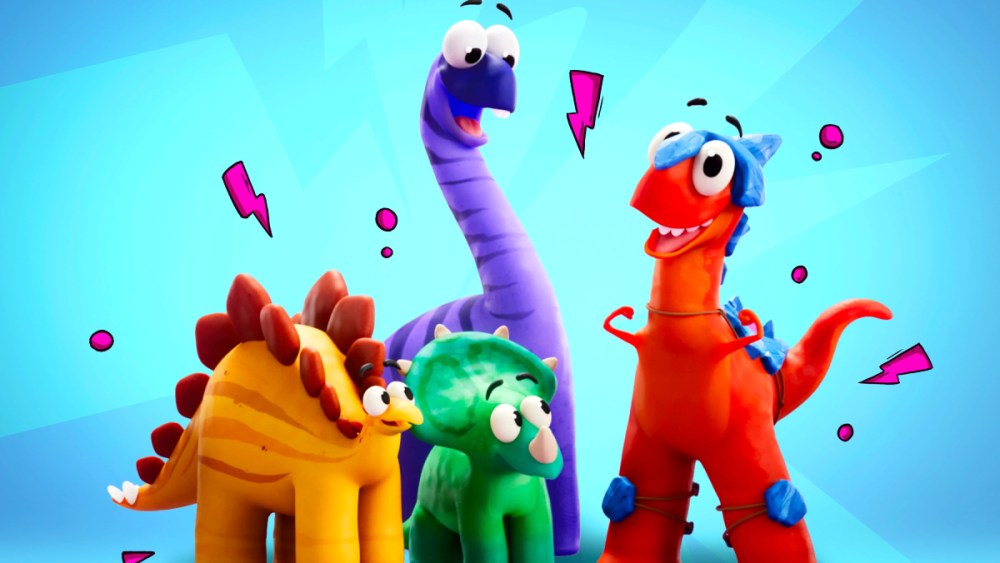In a session titled “Claynosaurz: The Rise of the Interactive Franchise: Why the Future Belongs to the Creator,” Claynosaurz co-founder and creative director Nick Cabana spoke to a packed View Conference Room in Turin about something many studios are wondering about but struggling to put into practice. Audience behavior has outpaced linear release cycles, and the next series should consider building across platforms and into the public sphere, with fans in the tent from day one.
“Entertainment is non-linear,” Kavanagh said, adding that for creators, “distribution is free.” His thesis is that when we design the way people already move through culture with short videos, games, GIFs, digital stickers, toys, and pop-ups, the “show” is just one node in a networked IP. “Especially today, kids want interaction,” he said. “We use the internet to create. We don’t isolate ourselves.”
Mr. Cabana laid out a plan to rapidly grow Cranosaurus, a dinosaur-driven transmedia brand founded by alumni from Sony, DreamWorks, Illumination, and Disney, over three years. The team self-funded their first short film, which later won a Webby Award, and used a high-fidelity digital collection of 10,000 pieces as a crowdfunding mechanism. These avatars are now running through every facet of the brand, from social clips, an upcoming mobile game with Gameloft, merchandise, live events, and even an upcoming YouTube-native show co-produced with MediaOne, Variety recently reported.
“We’re developing an episodic show. It’s going to be 40 episodes, seven minutes long. We’re going to go to YouTube soon,” Kavanagh said. This choice is intentional. Episodes are modular, “Family Guy” style, so you can start discovering wherever the algorithm reaches your audience. In parallel, Gameloft is developing full-length mobile games. Claynosaurz also layers a loyalty system and “proof of view” technology that can reward accounts for watching specific episodes, turning viewing into a gamified viewing loop.
Content Labs run on non-stop A/B testing. The team will “create inspiring content on social media”, weighing short reels, evergreen mini-stories and trending “cameos” for good measure, and measuring what spreads organically. “We are not fooling the algorithms,” Kavanagh insisted. He cited some 910,000 followers across platforms, nearly 1 billion video views, nearly 60 million individual clip views, and about 300 million views of Claynosaurz GIFs on Giphy. This is a company that has a lot in common with the tech startup sector’s approach to building an audience quickly and mastering monetization later.
The key is to get your audience involved, not just hooked. “We think of them as co-creators,” Kavanagh said, citing things like repeatedly “casting” community avatars into shorts, hiring prolific fan artists on the team, releasing free rigs to students at France’s Annecy Animation Festival, and encouraging memes, fan art and remixes where traditional IP might have a hard time getting past legal departments. Building “in public,” he argued, is a creative superpower. Rough storyboards, concept sheets, and desk videos spark comment-driven microiterations that build buy-in long before release.
Cabana said the latest digital Telegram sticker pack sold $223,000 worth in 20 seconds, and Popkins’ latest digital collection launch had $18 million in demand. The strange expression “In Demand” used a random blind box system where anyone could participate, but only some participants could win a popkin character. Those who missed out were automatically refunded. This novel strategy virtually guaranteed instant sellouts and provided concrete data in real time that showed what real consumer demand was. He bluntly described the strategy as “avoiding risk by pre-packaging intellectual property with culture.”
Kavanagh explained that this approach has already shifted the company’s influence to existing companies. “You don’t need a studio system,” he said. “The first year we made $3 million…the third year we made a total of $11 million,” he told Variety, adding that the value of the broader collectibles ecosystem is trading at about $40 million, and the company receives royalties on each transaction. He argued that organic traction will lead to more structured conversations with streamers, toy companies and retailers because the audience is clearly there.
For the studio, Cabana’s message is both a provocation and a market signal. The product in question may be a YouTube series rather than a pilot. Marketing itself can be successful. IP Bible may be updated weekly by the community. “Our mantra…was to meet the audience where they are, which is where they are. Entertainment is definitely non-linear now,” he said.
The north star, he suggested, is brand memory. It’s not just the shows someone watched, it’s the stickers they used, the pop-ups they lined up for, the toys they unboxed, the short stories they shared with friends because “That’s you.”
There’s nothing theoretical about the urgency for studios to focus on different approaches, and Kavanagh pointed to peers following in adjacent tracks, from Glitch’s “Digital Circus” to the creator’s commoditized viral character Nobody Sausage, as evidence that the model scales when character rather than form takes precedence. Because of its wide and passionate fan base, characters can later be incorporated into film or series formats, or anything else you can imagine.

